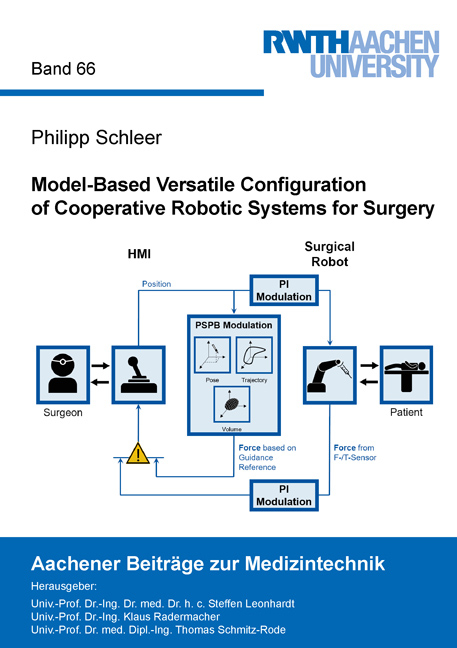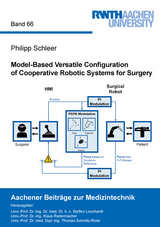Model-Based Versatile Configuration of Cooperative Robotic Systems for Surgery
Seiten
Machines are characterized by geometric accuracy, able to fuse information from multiple sensors, untiring and immune to radiation and infection. Humans are proficient at interpreting complex information and qualitative data even against high background noise levels. Since these skills are highly complementary, several cooperative strategies are used in surgical robotics to improve the surgical outcome. However, technical realizations vary throughout application fields, and there seems to be no consensus about which realization performs best for a given clinical scenario. To be able to assist the surgeon during an intervention by the best possible means, modular system design seems to be crucial.
Therefore, surgical robotics is analyzed from a human factors perspective to abstract systems and assistance functions for a modular architecture in the operating room. User studies are conducted with respect to the basic haptic guidance functions in simulation environments and a haptic feedback controller for bone surgery is presented. Several strategies to combine artificially generated haptic guidance forces and feedback from the remote environment while avoiding overlapping or masking of forces are investigated. An exemplary cooperative robotic system for surgery is built to validate the research results.
The presented generic robotic device profiles, in combination with the modular assistance functions and their recommendations for use, can foster integration of surgical robots into an open and modular network of medical devices in the operating room. This will enable surgical robots to become more versatile, provide a better benefit-to-cost ratio and increase market penetration. At the same time, usability for the surgeon and ultimately patient care can be enhanced.
Therefore, surgical robotics is analyzed from a human factors perspective to abstract systems and assistance functions for a modular architecture in the operating room. User studies are conducted with respect to the basic haptic guidance functions in simulation environments and a haptic feedback controller for bone surgery is presented. Several strategies to combine artificially generated haptic guidance forces and feedback from the remote environment while avoiding overlapping or masking of forces are investigated. An exemplary cooperative robotic system for surgery is built to validate the research results.
The presented generic robotic device profiles, in combination with the modular assistance functions and their recommendations for use, can foster integration of surgical robots into an open and modular network of medical devices in the operating room. This will enable surgical robots to become more versatile, provide a better benefit-to-cost ratio and increase market penetration. At the same time, usability for the surgeon and ultimately patient care can be enhanced.
| Erscheinungsdatum | 20.08.2021 |
|---|---|
| Reihe/Serie | Aachener Beiträge zur Medizintechnik ; 66 |
| Verlagsort | Düren |
| Sprache | englisch |
| Maße | 148 x 210 mm |
| Gewicht | 278 g |
| Themenwelt | Informatik ► Theorie / Studium ► Künstliche Intelligenz / Robotik |
| Technik ► Medizintechnik | |
| Schlagworte | Haptics • Human-Machine Interaction • Shared Control • Surgical Robotics |
| ISBN-10 | 3-8440-8149-6 / 3844081496 |
| ISBN-13 | 978-3-8440-8149-7 / 9783844081497 |
| Zustand | Neuware |
| Haben Sie eine Frage zum Produkt? |
Mehr entdecken
aus dem Bereich
aus dem Bereich
Buch | Softcover (2024)
REDLINE (Verlag)
CHF 27,95
Eine kurze Geschichte der Informationsnetzwerke von der Steinzeit bis …
Buch | Hardcover (2024)
Penguin (Verlag)
CHF 39,20




